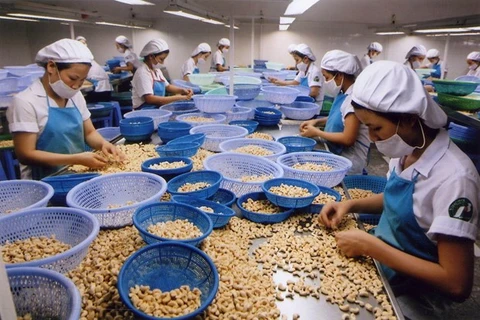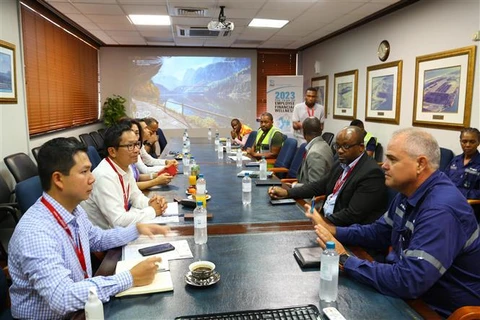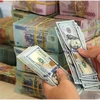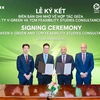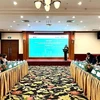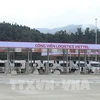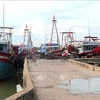Hanoi (VNA) - There remains an ample room for Vietnamese exports to Africa, as the country accounts for only 0.6% of the continent's total import of 600 billion USD per year, according to the Ministry of Industry and Trade, given opportunities brought about by the African Continental Free Trade Area (AfCFTA) agreement.
The Asian-African Market Department said that trade between Vietnam and Africa increased from 2.52 billion USD in 2010 to 5.5 billion USD in 2022.
Of the total, Vietnam’s exports were valued at more than 2.8 billion USD, resulting in a trade surplus of 226.3 million USD.
Vietnam mainly shipped rice (568.6 million USD), phones and component parts (355.6 million USD), computers and electronic products (210.4 million USD), and footwear (141.8 million USD) to Africa.
Meanwhile, it bought cashew nuts (1.1 billion USD), metals (484.1 million USD), and wood and wood products (114.3 million USD) from this continent.
In the coming time, to facilitate intra-bloc trade, African nations will pour more capital into infrastructure facilities, thus opening up more opportunities for Vietnamese goods to access more markets, including 15 landlocked countries, in Africa. At present, Vietnam’s main export markets in the region are major economies with seaports such as South Africa, Egypt and Nigeria.
Countries around the world are planning to study, negotiate and sign international trade agreements, especially free trade agreements (FTAs), with the African Continental Free Trade Area.
This will help them save time negotiating with individual countries or regions (Africa currently has 55 countries divided into eight economic regions). In fact, African countries have quite similar production structures, mainly primary products such as crude oil, raw agricultural products, minerals, and precious metals, according to the ministry.
Even if the AfCFTA agreement takes effect across the region, the continent still cannot guarantee the supply of machinery, equipment, rice, textiles, footwear, and processed aquatic products; and still has to depend on imports from foreign countries.
Therefore, there remains huge potential for Vietnam to export its key commodities such as rice, coffee, garment and textiles, footwear, and aquatic products to Africa.
Vietnam can increase its exports of textile, leather and footwear products to Africa by promoting competitive advantages such as low labour costs, good sewing techniques, and high quality products, if the nation or the Association of Southeast Asian Nations (ASEAN) negotiates a trade agreement with the AfCFTA, the ministry said.
The AfCFTA is the world’s largest free trade area bringing together the 55 countries of the African Union (AU) and eight Regional Economic Communities (RECs). The overall mandate of the AfCFTA is to create a single continental market with a population of about 1.3 billion people and a combined GDP of approximately 3.4 trillion USD./.
The Asian-African Market Department said that trade between Vietnam and Africa increased from 2.52 billion USD in 2010 to 5.5 billion USD in 2022.
Of the total, Vietnam’s exports were valued at more than 2.8 billion USD, resulting in a trade surplus of 226.3 million USD.
Vietnam mainly shipped rice (568.6 million USD), phones and component parts (355.6 million USD), computers and electronic products (210.4 million USD), and footwear (141.8 million USD) to Africa.
Meanwhile, it bought cashew nuts (1.1 billion USD), metals (484.1 million USD), and wood and wood products (114.3 million USD) from this continent.
In the coming time, to facilitate intra-bloc trade, African nations will pour more capital into infrastructure facilities, thus opening up more opportunities for Vietnamese goods to access more markets, including 15 landlocked countries, in Africa. At present, Vietnam’s main export markets in the region are major economies with seaports such as South Africa, Egypt and Nigeria.
Countries around the world are planning to study, negotiate and sign international trade agreements, especially free trade agreements (FTAs), with the African Continental Free Trade Area.
This will help them save time negotiating with individual countries or regions (Africa currently has 55 countries divided into eight economic regions). In fact, African countries have quite similar production structures, mainly primary products such as crude oil, raw agricultural products, minerals, and precious metals, according to the ministry.
Even if the AfCFTA agreement takes effect across the region, the continent still cannot guarantee the supply of machinery, equipment, rice, textiles, footwear, and processed aquatic products; and still has to depend on imports from foreign countries.
Therefore, there remains huge potential for Vietnam to export its key commodities such as rice, coffee, garment and textiles, footwear, and aquatic products to Africa.
Vietnam can increase its exports of textile, leather and footwear products to Africa by promoting competitive advantages such as low labour costs, good sewing techniques, and high quality products, if the nation or the Association of Southeast Asian Nations (ASEAN) negotiates a trade agreement with the AfCFTA, the ministry said.
The AfCFTA is the world’s largest free trade area bringing together the 55 countries of the African Union (AU) and eight Regional Economic Communities (RECs). The overall mandate of the AfCFTA is to create a single continental market with a population of about 1.3 billion people and a combined GDP of approximately 3.4 trillion USD./.
VNA


